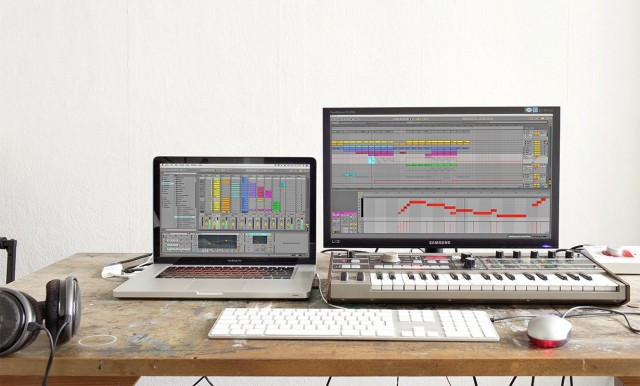
Look, two monitors! (And this could explain the popularity of this update – for many, the laptop is one display.) But there’s more in 9.1, including some subtle but critical bug fixes; now we get those details. Photo courtesy Ableton.
We broke the news of the headline Live 9.1 features – dual monitor support, melodic sequencing and automation step sequencing on Push, and high-quality sample rate conversion.
CDM may have had the exclusive on this, but it was still surprising to see a point release attract so many readers. The lesson seems clear: a targeted update with features requested by users can be as welcome – or even more welcome – than a big, paid update. Smaller developers have done those sorts of updates for some time (Reaper comes to mind), but perhaps it’s a lesson bigger players can apply.
Now you can try out the beta for yourself in a public beta. The software will be a free upgrade for all Live 9 users following the beta.
How to join the beta: Ableton has a signup for their bug reporting system, Centercode. You’ll have to provide (and verify) your email address, and some details on your computer and OS, which takes about five minutes. Once you’ve done that, you can download a single beta file that’s about 675 MB in size. (There isn’t yet a new Max for Live beta, only Live 9.1.) In the process, you can also be selected for future alpha and beta tests.
As with other versions of Live, you can run Live 9.1 beta alongside your existing copy of Live 9, so you can try out the new stuff without too much risk.
What’s in there: Of course, the biggest news we’ve already reported. Dual-monitor support is the feature that’s gotten the most attention; it’s useful not only for people with two displays, but also those who want to display side-by-side windows on a single display (or make use of virtual desktops).
Push also adds step sequencing options for melodies and automation, which is the feature that actually seemed to generate the most passionate enthusiasm, interestingly.
And export now uses the SoX resampler library – something you could have done previously (it’s an open source command-line tool), but which is certainly more convenient.
Now, with the release of the beta, we can look at everything else.
There’s a full feature list at Ableton’s site, but here are some highlights you might otherwise miss:
- Export is faster, thanks to multi-core support.
- Clip names are readable in the Disco skin.
- Warp markers save with clips when you check “Create Analysis File.”
- There are a range of fixes and “optimizations” to presets, in both internal Devices and Max for Live – found some interesting weirdness there, so this is good news.
- You can see which parameters are automated on Push. And there are lots of additional sequencing details to Push, not only the melodic and automation settings we discussed before.
- You can use the first encoder on Push to switch between Scales. (I like this, especially, as I’d complained to Ableton that I wanted to be able to switch modes when playing. I expect it wasn’t just me who said that – holla, mode nerds! Speaking of which…)
- Now the Minor Pentatonic Scale is actually a minor pentatonic scale. (Don’t make me come over there and go all Music Theory on you, Ableton!)
There’s another detail on Push that I really like, as it extends the potential of quick performing:
The second footswitch input now allows to control clip recording: A single tap triggers Push’s record button. A double-tap triggers Push’s “New” button.
Live of course doesn’t have a traditional takes and comps recording facility, but what it can do is use lots of clips to store different takes.
The full change log includes a lot of subtle bug fixes that continue to enhance stability. It’s clear these aren’t the sort of things that a reviewer can find; you really need to watch support forums and bug fixes for this information. (And that will always be my answer when people say “why aren’t you journalists reporting bugs?” The answer: we usually are, when we encounter and verify them, but we’re not the support department – or a massive user base.)